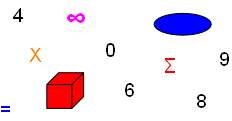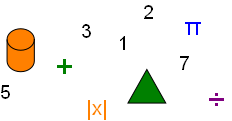



Factorials


Basics of Factorials
A Factorial is the number of unique combinations of the elements of a set so that each combination of elements represents a unique permutation of that set’s elements.
Let’s look at a few examples:
(The “!” after the integer tells us it is a Factorial)
0! = 1
1! = 1 = 1
2! = 2 × 1 = 2
3! = 3 × 2 × 1 = 6
4! = 4 × 3 × 2 × 1 = 24
n! = n (n − 1) (n − 2)… 3 × 2 × 1
Yes, 0! = 1. This is because an empty set, having no elements, can be ordered by (organized) only as { }, there is no other order for an empty set.
The Permutations of 0! is 1: { }
The permutations of 1! is 1: {1}
The permutations of 2! is 2: {1,2} {2,1}
The permutations of 3! is 6: {3,2,1} {1,2,3} {2,1,3} {2,3,1} {3,1,2} {1,3,2}
It is easy to see that as the integer of the Factorial becomes larger the complexity to determine the unique combinations, as permutations of set elements, quickly nears impossible…
5! = 5 × 4 × 3 × 2 × 1 = 120
6! = 6 × 5 × 4 × 3 × 2 × 1 = 720
7! = 5,040
8! = 40,320
9! = 362,880
10! = 10 × 9 × 8 × 7 × 6 × 5 × 4 × 3 × 2 × 1 = 3,628,800
and observe:
3! = 6
4! = 3! × 4 = 6 × 4 = 24
5! = 4! × 5 = 24 × 5 = 120
6! = 5! × 6 = 120 × 6 = 720
From this observation we can infer that a Factorial, (n + 1)! , is equal to n! (n + 1); Where n! is read “n factorial”. That is, the permutations of the next Factorial can always be determined by multiplying the permutations of the current Factorial, n!, by the next integer increment of the current Factorial. A formal math definition of a Factorial can now be given as:
(n + 1)! = n! (n +1)
A Factorial is an integer product:
n! = n (n − 1) (n − 2) … 3 × 2 × 1
Using 6! to equate factors to the equation n!:
6! = 6 × 5 × 4 × 3 × 2 × 1 = 720
n = 6
n − 1 = 5
n − 2 = 4
n − 3 = 3
n − 4 = 2
n − 5 = 1
This is multiplication to determine the number of permutations, unique combinations, for a given Factorial. This being said, then one Factorial can be divided by another Factorial, that is, division and multiplication are reciprocal operations. Indeed, Factorials can be divided to determine the difference of their permutations with the stipulation that for any n! / i! , 0 ≤ i ≤ n.
Let’s divide 10! by 6! :
10! / 6! =
(10 × 9 × 8 × 7 × 6 × 5 × 4 × 3 × 2 × 1) / (6 × 5 × 4 × 3 × 2 × 1) =
(10 × 9 × 8 × 7 × 6 × 5 × 4 × 3 × 2 × 1) / (6 × 5 × 4 × 3 × 2 × 1) =
10 × 9 × 8 × 7 = 5,040
… we observe that the fraction can be reduced.
If we already know the permutation values, the numerator and denominator, of the factorial division:
10! = 3,628,800
6! = 720
3,628,800 / 720 = 5,040
10! / 6! = 5,040
If we do not know the permutation values of the numerator or denominator factorials of the division:
20! / 18! 2! =
(The numerator is determined by denominator 18! canceling, or reducing, the first 18 integer digits of the numerator 20! to 1/1, the remaining values not reduced, are greater than 18. The integers remaining are 19 and 20)
20 × 19 / 2! =
20 × 19 / 2! =
(Evaluating 2!; 2! = 2)
20 × 19 / 2 =
10 × 19 / 1 = 190
Quotients of Factorials
A special symbol with a special definition to find quotients of factorials:
(
n
i
)
“This special math symbol does not state n! is to be divided by i!”
The definition is
(
n
i
)
= n! / (i! (n − i)!)
i and n are integers where 0 ≤ i ≤ n
If asked to find the quotient of:
(
7
4
)
= n! / (i! (n − i)!)
= 7! / (4! (7 − 4)!) = 7! / (4! 3!) = (7 × 6 × 5 × 4 × 3 × 2 × 1) / ((4 × 3 × 2 × 1) (3 × 2 × 1))
= (7 × 6 × 5) / (3 × 2 × 1) = 210 / 6 = 35
When n = 7 and i = 4 the resulting factorial equation is 7! / (4! 3!).
Let’s try n = 7 and i =3…
(
7
3
)
= 7! / (3! (7 − 3)!) = 7! / (3! 4!) = 35
This works for any values of n and i to find quotients of factorials.
(
8
5
)
= n! / (i! (n − i)!)
= 8! / (5! (8 − 5)!) = 8! / (5! 3!) = (8 × 7 × 6 × 5 × 4 × 3 × 2 × 1) / ((5 × 4 × 3 × 2 × 1) (3 × 2 × 1))
= (8 × 7 × 6) / (3 × 2 × 1) = 336 / 6 = 56
(
8
3
)
= 8! / (3! (8 − 3)!) = 8! / (3! 5!) = 56
This behavior to determine the denominator for factorial division can be described by:
(
n
i
)
=
(
n
n − i
)
(
9
7
)
=
(
9
9 − 7
)
=
(
9
2
)
The following math shows us why:
(
n
i
)
=
(
n
n − i
)
Observe that
(
n
i
)
= n! / (i! (n − i)!)
and
(
n
n − i
)
= n! / ( n! − (i! (n − i)!)
= n! / ( (n − i)! (n − (n − i))! ) = n! / ( (n − i)! i! )
Note that [n − (n − i)]! = [n − n + i]! = i!
thus
(
n
n − i
)
= n! / (i! (n − i)!) =
(
n
i
)
Copyright © DigitMath.com
All Rights Reserved.